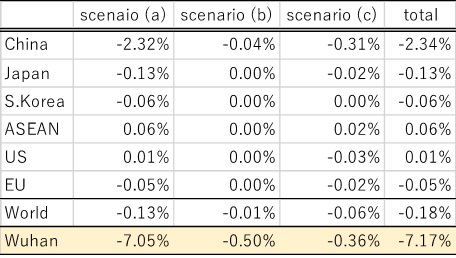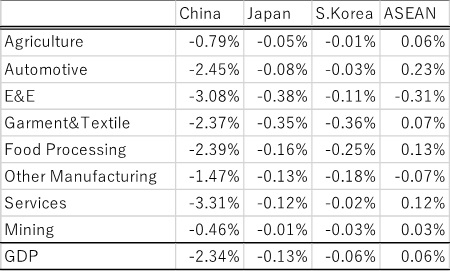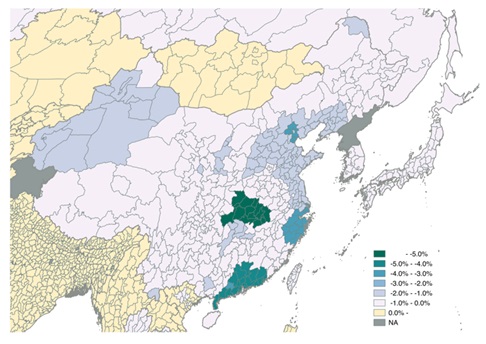Impact of the 2019 Novel Coronavirus on the Chinese and Asian Economies: Analysis Using IDE-GSM
IDE Policy Brief
No.10
Satoru KUMAGAI, Toshitaka GOKAN, Kenmei TSUBOTA, Ikumo ISONO, Kazunobu HAYAKAWA, Souknilanh KEOLA
PDF (495KB)
- The economic impact of the 2019 novel coronavirus is estimated by IDE-GSM, a general equilibrium model developed by IDE-JETRO. According to the assumed scenarios, an outbreak in China lasting for one month will cause China's GDP to contract by as much as 2.3%.
- The simulation results indicate that an outbreak in China will reduce Japan and South Korea's GDPs by 0.13% and 0.06%, respectively while increasing the GDP across ASEAN member countries by 0.06%, although Outbreaks outside of China were not assumed in this analysis.
- If we look at the results by industry, the most negatively impacted industries in China would be the service sector, the electrical and electronics sector, and the automotive sector, while the worst affected sectors in Japan would be the electronics, garment and textile, and food processing sectors.
- The decrease in labor input would have the most significant impact on the Chinese economy, with the next largest impact coming from the decline in international passenger traffic and blockades of domestic transportation.
Introduction
Since the beginning of January 2020, the 2019 novel coronavirus (COVID-19) has infected more than 118,000 people and caused more than 4,000 deaths, predominantly in China, and the infection is continuing to spread (according to World Health Organization (WHO) figures, as of March 11, 2020). The slowdown in business activity has been most pronounced in Hubei Province, where Wuhan City is the capital, in which the infection is most severe, but production in the rest of China was also slow to resume after the Lunar New Year holiday.
The spread of COVID-19 will almost certainly affect the economy in China, as well as the rest of Asia, but the continuously changing situation has prevented detailed estimation of the magnitude of its impact. This study uses the Geographical Simulation model developed by the Institute of Developing Economies (IDE-GSM) to estimate its impacts on economic activity by country and region.
IDE-GSM is a Computational General Equilibrium (CGE) model that is being developed by the Institute of Developing Economies since 2007. IDE-GSM, which is based on spatial economics (Kumagai et. al 2013), is utilized to analyze the economic effects of international infrastructure development projects. IDE-GSM enables various hypothetical calculations to be performed by changing the parameters or the transportation network data, and in this study, we used it to estimate the impact of COVID-19 by changing following factors: a) the decrease in labor input; b) transport blockades in Hubei Province; and c) restrictions on international travel between China and other countries.
Scenario
The effects of COVID-19 were calculated according to the following scenarios:
a) Decrease in labor input: In Hubei Province, labor input in the service industry is reduced by 70%, while, in other industries, it is reduced by 95%. In other cities and provinces, labor input is reduced by 10%–50% based on the provincial inflow/outflow of migrant workers1.
b) Transportation blockades: A 72-hour wait is assumed at the provincial borders for all roads and railways in and out of Hubei Province.
c) Restrictions on international travel: It is assumed that all international flights between cities in China and other countries have been suspended and that nontariff trade barriers (NTBs) for services have double to simulate the impact of restrictions on international passenger traffic.
In total: The three scenarios above are applied simultaneously.
These scenarios were applied for a period of 1 year from 2020. The differences in regional GDP between the baseline, in which these scenarios were not applied, and the results of simulation under the above scenarios, were taken to represent the economic impact of COVID-19.
IDE-GSM is an annual model, so the effects across one year were converted to a one-month impact by dividing the results by 12.
If the COVID-19 outbreak has been declared over, labor input and logistics are expected to return to their previous levels quickly, and it can be assumed that unmet demand, once it can be fulfilled, will offset some of the negative impacts on the economy. The figures provided here can, therefore, be seen as the upper limits of the outbreak's effects.
Estimated Results
The effects of the 2019 novel coronavirus by scenario, country, and region are shown in Table 1. For every one-month that economic activities continue to be restricted, China's GDP will be reduced by 2.3%. Positive and negative effects are mixed for other countries (Note that the impact of COVID-19 outbreaks outside of China are not included in the scope of this simulation.) The decrease in labor input is the scenario that has the most significant impact, followed by the decline in international travel, and then by the effect of transportation blockades.
For Wuhan City, which has been under lockdown since January 23, 2020, the negative impact of transportation blockades is more significant than that of restriction on international travel.
Table 1: The impact of COVID-19 by scenario (relative to baseline GDP, converted into monthly impact).

Table 2: Impact of COVID-19 by industry (percentage of baseline GDP, converted into monthly impact)

Figure 1: Regional impact of COVID-19 (percentage of baseline GDP, converted into monthly impact)

Conclusion
As noted above, an outbreak in China lasting for one month will reduce China's GDP by as much as 2.3%; Japan and Korea will see slightly negative impacts; and ASEAN will experience a slight increase. Reduced labor input has the most significant impact, followed by a decline in international passenger traffic, and then by transport blockades at the borders of Hubei Province. Therefore, returning labor input to normal level in China, while simultaneously controlling the spread of the infection, are the keys to minimizing the outbreak's impact on the economies of China and East Asia.
Conversely, although COVID-19 might have a tremendous temporary impact on the economies of affected countries, physical production facilities are not being damaged, which means the production is expected to recover quickly, once labor input can be normalized.
Footnote
- In provinces other than Hubei, the parameters used are as follows. 10% decrease: Liaoning, Xinjian Uygur Autonomous Region, Shandong, Hebei, Shanxi, and Ningxia. 15% decrease: Jiangsu. 40% decrease: Shanghai, Zhejiang, Beijing, and Tianjin. 50% decrease: Guangdong. Interprovincial migrant data is based on figures taken from Regional China: internal migration, July 13, 2018, by The Economist Intelligence Unit.
Reference
Kumagai, S., Hayakawa, K., Isono, I., Keola, S., and Tsubota, K. (2013). Geographical simulation analysis for logistics enhancement inAsia. Economic Modelling, 34, 145-153.
The views expressed in the document are those of the author(s) and neither the Institute of Developing Economies nor the Japan External Trade Organization bears responsibility for them.
©2020 by author(s)
No part of this publication may be reproduced without the prior permission of the author(s).


